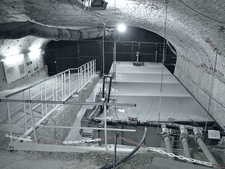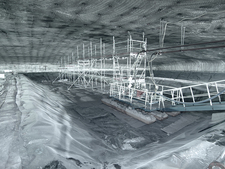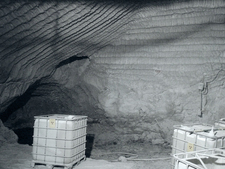-
Topics
subnavigation
Topics
What is the Asse?
- History of the Asse
- The mine
- Radioactive waste
- Influent saline solutions and brines
- The operator
What happens in the Asse?
Influent saline solutions and brines
Daily, around 12.5 cubic metres of saturated groundwater (influent saline solutions) enter the Asse mine via its southern flank in a depth of 500 to 600 metres through clefts in the surrounding rock. These influent saline solutions do not dissolve any further rock salt in the mine.
Apart from the main collecting point in a depth of 658 m there is a number of additional places in the mine where saline solutions accumulate. These are not always saline solutions flowing into the mine from outside (external solutions) but also saline solutions that were trapped when the salt rock formed (internal solutions) or which originate from the operation of the mine (e.g. potash mining).
Collecting places of influent saline solutions

![]() Main collecting place of influent saline solutions on the 658-m level (as of June 2011)
Main collecting place of influent saline solutions on the 658-m level (as of June 2011)
Per day around 12.5 cubic metres of saline solutions enter the mine in a depth of 658 metres, above the emplacement chambers, around 11.5 cubic metres of saline solutions are collected daily. They are collected in large collecting containers on the 490-m level and pumped out of the mine to the surface where they are disposed of or processes industrially. They are not radiologically inoccuous. About 0.8 cubic metres per day are collected on the 725-m level. They are not contaminated either.
A small amount (ca. 20 litres per day) is collected in a depth of 750 m where the major part of the radioactive waste is stored. In front of emplacement chamber 8 ca. 13 to 16 litres of saline solution is collected daily – that is less than 0.1 per cent of the saline solution accumulating daily. The solution is contaminated with tritium (H-3) and caesium-137, the levels being above the exemption limits. Therefore they must be treated, utilised or disposed of as radioactive waste.
"Lex Asse" facilitates handling of contaminated brines
Since it came into effect in April 2013, a statutory regulation, the so-called "Lex Asse" (§ 57b AtG) makes it possible for the BfS to utilise contaminated brines for the production of a special type of concrete. If the brines do not exceed a defined level of contamination, the concrete produced with it is used for stabilization purposes in deeper areas of the mine. This requires a previous notice to the Lower Saxon Environment Ministry (NMU).
Consequences for the mine's stability
The influent saline solutions cannot dissolve the salt dome where the chambers of the southern flank are located and where also the radioactive waste has been emplaced. The solutions are saturated with rock salt, thus they cannot take up additional rock salt. However, they can additionally take up potash salts (carnallitite). Should the solutions advance up to the potash seam, they could affect the potash salt and so additionally weaken the mine's stability.

![]() Collecting container for influent saline solutions on the 490-m level after remediation (June 2011)
Collecting container for influent saline solutions on the 490-m level after remediation (June 2011)
Management of influent saline solutions
Before the influent saline solutions can be removed from the 490-m level of the Asse mine, they need to be "cleared". That means that their content of radionuclides is subject to strict limits. In 2009, the BfS developed a technical concept which led to a further reduction of the uptake of radionuclides in the influent saline solutions.
Until December 2016, released saline solutions have been delivered to the abandoned Mariaglück mine near Höfer. Since 2017 the saline solution are either disposed of or processed industrially.
Brines
Below the 658-m level, the volumes and contamination of the brines vary a lot. Brines which could be cleared but are not removed by the BfS on account of the BfS's commitment, are utilised inside the mine to produce a special type of concrete.
Altogether there are around 340 active and former (dry) locations in the Asse II mine where brines accumulate. Each location is monitored on a regular basis. In this process it is determined how much brine accumulates, where it comes from and whether it is contaminated or, respectively, to what extent.

![]() Brine swamp in front of emplacement chamber 12
Brine swamp in front of emplacement chamber 12
Swamp in front of emplacement chamber 12
Radioactively contaminated brine that had accumulated over years in front of emplacement chamber 12 in the Asse mine and whose further handling had been unclear until the beginning of 2013, has meanwhile been removed. The management of the brine becomes possible on account of the new law on Asse (Lex Asse) passed by the Bundestag. The law permits the storage of radioactively contaminated substances and further utilisation for as long as the ten-fold of the exemption limit – up to this limit the handling of radionuclides does not need to be licensed – is not exceeded and the health of staff and population is not put at risk. This is the case with the brine in front of chamber 12.
The BfS has initially pumped out altogether around 17 cubic metres of solution in front of chamber 12 on the 750-m level of the Asse mine and has had the brine taken to special collecting containers in a different part of the mine. The brine is to be further processed to salt concrete in the mine. The removal of the brine enables the next step in the retrieval of the waste from the Asse mine. Besides it makes emergency preparedness easier.
As the former operator of Asse, Helmholtz Zentrum München, had transported contaminated brines from the "swamp” in front of chamber 12 to another part of the mine without having been granted a licence for use and manipulation according to Radiation Protection Ordinance. They had been taken through a bore hole from the 750-m level to an area in a depth of approximately 975 m.
In February 2009, it became known that as early as in 1988, radioactively contaminated brines from the "swamp" in front of chamber 12 had been pumped off and transported in steel containers into chamber 11 on the 700-m level. There the brines were dumped onto stacked rock pieces (salt debris) of the partially backfilled chamber.
State of 2017.02.27

